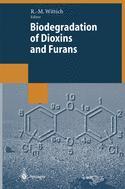Description
Biodegradation of Dioxins and Furans, Softcover reprint of the original 1st ed. 1998
Environmental Intelligence Unit Series
Coordinator: Wittich Rolf-Michael
Language: English
Subjects for Biodegradation of Dioxins and Furans:
Publication date: 12-2012
289 p. · 15.5x23.5 cm · Paperback
289 p. · 15.5x23.5 cm · Paperback
Description
/li>Contents
/li>Comment
/li>
Bioremediation of organic pollutants and heavy metals by use of microorganisms represents a safe, inexpensive, and environmentally-friendly concept in modern environmental engineering. During the last three decades intense efforts have been made by microbiologists and environmental engineers in the isolation and characterization of microorganisms capable of degradation, transformation and detoxification of recalcitrant chemical compounds of environmental concern: (polyhalogenated) dibenzo-p-dioxins, dibenzofurans, and diphenyl ethers. Special emphasis is placed on the potential of molecular biology techniques to improve presently available biocatalysts.
1. Aerobic Degradation by Bacteria of Dibenzo-p-Dioxins, Dibenzofurans, Diphenyl Ethers and Their Halogenated Derivatives.- 2. Anaerobic Bacterial Dehalogenation of Polyhalogenated Dioxins and Furans.- 3. Biodegradation of Dioxin and Dioxin-Like Compounds by White-Rot Fungi.- 4. Molecular Genetics of the Degradation of Dioxins by Bacteria.- 5. Biotransformation of Dioxin-Like Compounds by Eukaryotic Cells.- 6. Bioavailability of Dioxin-Like Compounds for Microbial Degradation.- 7. Structure-Biodegradability Relationships for Chlorinated Dibenzo-p-Dioxins and Dibenzofurans.- 8. Biodegradation of Diaryl Ether Pesticides.- Color Figures.
Remediation of organic pollutants and heavy metals can be extremely expensive.
This book shows how this can be done in a safe, inexpensive and environmentally friendly way using microorganisms.
© 2024 LAVOISIER S.A.S.




